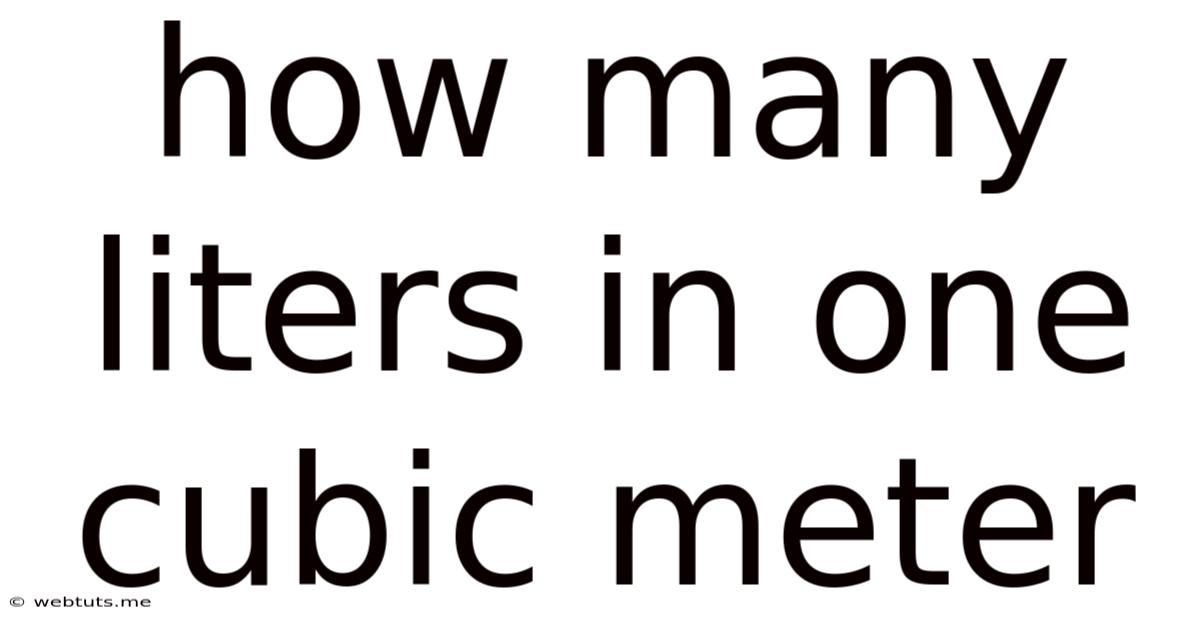How Many Liters In One Cubic Meter
Webtuts
May 12, 2025 · 4 min read

Table of Contents
How Many Liters in One Cubic Meter? A Comprehensive Guide
Understanding unit conversions is crucial in many fields, from engineering and construction to everyday tasks like cooking and gardening. One common conversion that often causes confusion is the relationship between liters and cubic meters. This comprehensive guide will delve deep into this conversion, exploring the underlying principles, providing practical examples, and addressing common misconceptions. We'll also explore the broader context of volume measurement and its applications.
Understanding Liters and Cubic Meters
Before jumping into the conversion, let's clarify the units involved:
Liters (L): A unit of volume in the metric system, primarily used for measuring liquids. It's a relatively small unit, suitable for measuring things like milk in a carton or water in a bottle.
Cubic Meters (m³): A unit of volume representing a cube with sides measuring one meter each. It's a much larger unit, typically used for measuring larger volumes like the capacity of a swimming pool, the volume of a room, or the amount of concrete needed for a foundation.
The Conversion: Liters to Cubic Meters
The key to understanding the conversion lies in remembering that a liter is defined as a cubic decimeter (dm³). A decimeter is one-tenth of a meter (0.1 m). Therefore, a cube with sides of 1 decimeter each has a volume of 1 liter.
Consider a cubic meter. Since 1 meter is equal to 10 decimeters, a cubic meter can be visualized as a larger cube containing 10 x 10 x 10 = 1000 smaller cubes, each with sides of 1 decimeter. Each of these smaller cubes represents 1 liter.
Therefore, 1 cubic meter (m³) is equal to 1000 liters (L).
This simple conversion factor is fundamental in numerous calculations. Let's illustrate this with some examples:
Example 1: Calculating the Water Capacity of a Tank
Imagine a water tank with dimensions of 2 meters (length) x 1 meter (width) x 1.5 meters (height). To calculate its volume in cubic meters:
Volume = Length x Width x Height = 2 m x 1 m x 1.5 m = 3 m³
Now, to convert this volume to liters:
Volume in liters = 3 m³ x 1000 L/m³ = 3000 L
The water tank can hold 3000 liters of water.
Example 2: Converting Liquid Volume from Liters to Cubic Meters
Let's say you have 5000 liters of paint. To convert this volume to cubic meters:
Volume in cubic meters = 5000 L / 1000 L/m³ = 5 m³
You have 5 cubic meters of paint.
Beyond the Basic Conversion: Practical Applications
The conversion between liters and cubic meters is not just a theoretical exercise; it has widespread practical applications:
- Construction and Engineering: Calculating the amount of materials needed for construction projects, such as concrete, soil, or water for mixing.
- Agriculture: Determining the volume of water needed for irrigation, the capacity of storage tanks for fertilizers, or the size of silos for grain.
- Environmental Science: Measuring water flow in rivers and streams, calculating the volume of pollutants in water bodies, and assessing the impact of environmental changes on water resources.
- Aquaculture: Determining the size of fish tanks, calculating water volume for optimal fish health, and designing efficient water filtration systems.
- Shipping and Logistics: Calculating the volume of cargo in shipping containers, optimizing space utilization, and determining transportation costs.
- Household Applications: Calculating the capacity of swimming pools, determining the volume of water used for household purposes, and planning for water storage during emergencies.
Common Misconceptions and Troubleshooting
While the conversion itself is straightforward, some common misconceptions can lead to errors:
- Confusing Liters and Kilograms: Liters measure volume, while kilograms measure mass. You cannot directly convert between them without knowing the density of the substance. For example, 1 liter of water weighs approximately 1 kilogram, but 1 liter of oil weighs less.
- Incorrect Unit Conversions: Always double-check your unit conversions to avoid mistakes. Pay close attention to the units involved in each step of your calculation.
- Ignoring Significant Figures: In scientific and engineering calculations, pay attention to the number of significant figures to ensure accuracy.
Expanding Your Understanding: Other Volume Units
Understanding liters and cubic meters is a crucial stepping stone to mastering other volume units. Here's a brief overview:
- Milliliters (mL): 1 mL = 0.001 L
- Cubic Centimeters (cm³): 1 cm³ = 1 mL
- Cubic Kilometers (km³): 1 km³ = 1,000,000,000 m³
Mastering these conversions will enable you to handle a wider range of volume calculations effectively.
Conclusion: Mastering the Conversion for Success
Understanding the conversion between liters and cubic meters is an essential skill with far-reaching applications. By mastering this conversion and understanding the underlying principles, you can confidently tackle numerous problems in various fields, from everyday calculations to complex engineering projects. Remember the simple yet powerful relationship: 1 cubic meter equals 1000 liters. With this knowledge, you can confidently navigate the world of volume measurements and utilize this information to solve real-world problems effectively and efficiently. Regular practice and attention to detail will ensure accuracy and prevent common errors. By expanding your knowledge to encompass other volume units, you will significantly enhance your understanding of measurement systems and their applications.
Latest Posts
Latest Posts
-
90 Days From September 28 2024
May 12, 2025
-
What Is 9 5 Inches In Cm
May 12, 2025
-
How Many Fluid Ounces Are In A Can Of Beer
May 12, 2025
-
How Many Micrometers In One Meter
May 12, 2025
-
How Many Inches Is 2 3 Cm
May 12, 2025
Related Post
Thank you for visiting our website which covers about How Many Liters In One Cubic Meter . We hope the information provided has been useful to you. Feel free to contact us if you have any questions or need further assistance. See you next time and don't miss to bookmark.